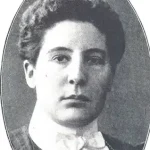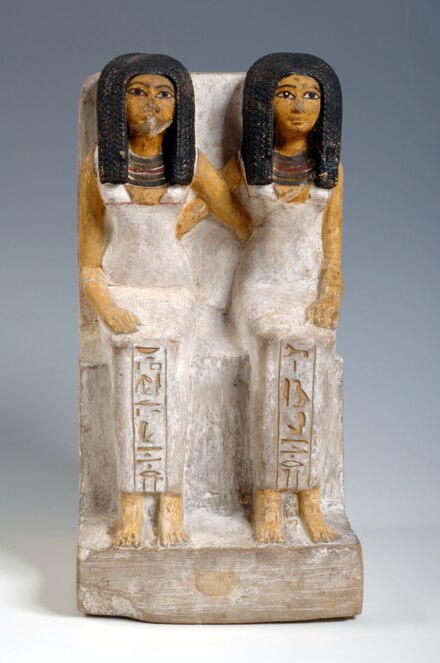Lesbian Herstory Timeline
 Statue of Idet and Ruiu, c 1480-1390 BCE, painted limestone – Museo Egizio (Turin)
Statue of Idet and Ruiu, c 1480-1390 BCE, painted limestone – Museo Egizio (Turin)
C 3056(Wikimedia Commons) . Were they lovers or mother and daughter?
Timeline of Lesbian Relevant Events
[Under construction. To fill in the gaps, please contact us!]
Archaeological research has found the oldest representations of humans in art and objects were mostly of women. In the absence of written records, they are a symbolic system of 'silent witnesses' in which women were the sex made visible.
Many figures of female couples also have been found (male-female couples are very rare), but their meanings are not clear. They could represent 'mother and daughter, sisters, priestesses who together oversaw the cult of the twin goddesses, double queens, handed down from the Amazon myths, or simply lovers.'
Marija Gimbutas, an archaeologist born in Lithuania, who migrated to the US as the result of World War II, used her knowledge of folk culture to interpret all the ancient objects as goddess figures, producing a controversial theory of Old Europe as a peaceful goddess-worshipping culture.
Possible lesbian relationships were described in the Code of Hammurabi of ancient Mesopotamia, which allowed an al-zikrum, or "woman-man," to marry another woman; Sal-nu-bar also were women allowed to marry, but were forbidden to have children.
Fragments of love poems written to women by Sappho and Alcman still survive. Greek men largely didn't write about lesbianism, perhaps not even allowing for love between women to be identified as sexual. Occasional depictions of lesbian love have been found in ancient Greek art.
The Arthashastra, an ancient Indian text about statecraft, politics, economics and military strategy, describes the first recorded criminalisation of non-vaginal sex (ayoni), where fines were applied. Ayoni is a broad concept that can include oral, anal, and manual sex, bestiality, and even forms of masturbation
Lesbian sex was treated as a minor offence with a lesser fine.
The Manusmriti, a first century legal text, applies a very small fine for sex between nonvirgin women; while the one who "manually deflowers a virgin" was sentenced to the loss of two fingers; and between two 'virgin' women, the one who performs vaginal penetration had to pay double the other woman's dowry and was given ten whiplashes. There was no punishment for mutual oral or manual lesbian sex.
Masawaiyh (c 777–857) reported in a medical text that lesbianism was caused by the mother's diet: Lesbianism results when a nursing woman eats celery, rocket, melilot leaves and the flowers of a bitters of a bitter orange tree. When she eats these plants and suckles her child, they will affect the labia of her suckling and generate an itch which the suckling will carry through her future life.
Al-Kindi (c. 801–873 AD) wrote: Lesbianism is due to a vapor which, condensed, generates in the labia heat and an itch which only dissolve and become cold through friction and orgasm. When friction and orgasm take place, the heat turns into coldness because the liquid that a woman ejaculates in lesbian intercourse is cold whereas the same liquid that results from sexual union with men is hot. Heat, however, cannot be extinguished by heat; rather, it will increase since it needs to be treated by its opposite. As coldness is repelled by heat, so heat is also repelled by coldness.
The Encyclopedia of Pleasure or Jawāmiʿ al-Ladhdhah (جوامع اللّذّة) is the earliest existent Arabic erotic work. It documents the first lesbian love story in Arab culture, about a female poet named Hind Bint al-Nu’man (known as Al-Hurqah (هند بنت النعمان), and Hind Bint al-Khuss al-Iyadiyyah (known as al-Zarqa’) from Yamama in Arabia.
The earliest reference to legal punishment for lesbianism (as for male homosexuality) in Western Europe is in the Old French legal treatise Li livres de jostice et de plet. Penalties for men were: castration for the first offence, dismemberment for the second, and death by burning for the third. For lesbians, dismemberment for the first and second offences, and burning for the third.
Male homosexual relationships first criminalised in England when the act of anal intercourse (buggery) was criminalised. The law applied to both men and women, but when applied to men it acted as a homosexist warning to the male brotherhood to use their penis 'morally.' The focus on the act of penile penetration meant that lesbian sexuality was not criminalised.
'Lesbian' first used as an adjective to refer to people from the Greek Island of Lesbos.
Eleanor Butler (1739-1829) met Sarah Ponsonby (1755-1831). Both were members of wealthy families from the Irish aristocracy and determined not to be married off. They fought parental efforts to stop them leaving Ireland but they eventually were allowed to go to Wales, where they finally settled down in 1780 and lived as a couple for nearly fifty years with a servant, Mary Carryl, and a series of dogs all named Sappho.
The diaries of Anne Lister (1791–1840), a wealthy Englishwoman, are the first recorded accounts of lesbian love in the modern West.
The emerging suffragist and women's movement encouraged greater independence for middle & upper-class women through gaining educational and employment opportunities. Passionate friendships became evident in novels and real life.
Jennings, Rebecca 2007. Lesbian History of Britain. Love and Sex between Women Since 1500, Greenwood, Oxford.
Karl Heinrich Ulrichs (1825–95), a German law student and journalist but not a medical doctor, was sexually attracted to men and an early campaigner for law reform to end disrimination against homosexuals. In 1864, using the pseudonym Numa Numantius, he published his Forschungen über das Rätsel der mannmännlichen Liebe (Researches on the Riddle of Male–Male [Man-to-Man] Love), which first used the term Urning, for male homosexual, and the complementary word Urningin, for lesbian. Uranian became popular for either sex.He was an early proponent of the idea that sexuality was caused by an inner spirit in which, for example, a homosexual man has an inner female spirit that would leas him to be attracted to another man.
Source: Rictor Norton, A Citique of Social Constructionism and Postmodern Queer Theory
'Homosexuality' coined in an anonymous pamphlet by its author, journalist Karl Maria Kertbeny, in Germany.
Source: M Herzer 1985, ‘Kertbeny and the nameless love,’ J Homosex, Fall;12(1):1-26. doi: 10.1300/j082v12n01_01.
Any male homosexual act made illegal in the UK, even committed in private. The law was used to prosecute Oscar Wilde in 1895.
Sexology 'experts' in England and Europe (Havelock Ellis, Richard von Krafft-Ebing, Freud) developed theories of 'inversion,' Uranism,' 'arrested development,' which raised questions about emotional or romantic friendships between women.
Jennings (2007) A Lesbian History of Britain. Love and Sex Between Women since 1500.
For an origins story of the 'born in the wrong body' idea and lurid stories of conspiracies that blame women (sound familar to late modern TERF ears?), see here.

Lesbian 'Anna Rüling' has been credited with the first lesbian activist political speech when she addressed the relationship between the women's movement and homosexuality in a speech in Berlin (Leidinger 2004).
South Australia decriminalised homosexuality.
Raclyffe Hall's novel The Well of Loneliness published, tried and banned for obscenity in 1928. Lesbian communities, bars and clubs formed in the 1920s (eg in Paris, Berlin, San Francisco). Legislation to criminalise lesbianism in UK introduced, debated and defeated
The term was first published in papers presented by Robert Stoller and Ralph Greenson at the 23rd International Psycho-Analytic Congress in Stockholm (Byrne (2023) 'The origin of gender identity,' Letter to the Editor, Archives of Sexual Behavior, 52, pp. 2709-2711, https://doi.org/10.1007/s10508-023-02628-0
Following the etablishment of Daughters of Bilitis in the US, an organisation of the same name was established in Melbourne, Australia. Soon after, the name of the Australian group was changed to the Australian Lesbian Movement. Melbourne,
Formation of CAMP in Balmain NSW announced by Christabel Poll and John Ware in the first edition of the newsletter CAMP INK, soon after 2 articles in The Australian by Janet Hawley 'Homosexuals form group aimed at ending an aura of mistique, secrecy' and 'Couples'. Within a year, a national network of CAMP and Society Five groups were established in Queensland, Victoria, ACT, Tasmania and most universities, where it was known as Campus CAMP.
Clover was established as a 'conservative camp ladies' group in Sydney. Permanent clubrooms were established in Victoria Road, Drummoyne with a bar and disco every Friday night. The women's liberation movement brought a flourishing of women's dances, Ruby Red's bar & nightclub and other women-only social space for more politically active lesbian feminists in Sydney.
1,000 acres of land on the Mid-North Coast of NSW were found by Kerryn Higgs and purchased from her prize money for the manuscript of her first novel, supplemented by fundraisers run by the newly formed Firestone Mountain Cooperative. This land was informally named 'The Mountain'. Two more adjacent purchases increased the total size of women's land to 3,000 acres: The Valley in 1980 and Herland in 1982. Keryn's novel, All That False Instruction. A Novel of Lesbian Love, published by Angus & Robertson in 1975 under the pseudonym Elizabeth Riley was the first Australian lesbian novel. It was re-published in 2001 under Kerryn's name by Spinifex Press. (Source: Sand Hall, Amazon Acres, You Beauty. Stories of Women's Lands Australia, Shell Publishing, Wollongong)
On 24 June,after a march in the morning to celebrate International Gay Solidarity Day, a street party was held in the evening for the first Sydney Gay and Lesbian Mardi Gras. Fifty-three people were arrrested. More demonstrations later against police violence and for the right to protest peacefully led to a total of 178 arrests. All charges were dropped the following year. (Source: Robyn Kennedy & Robyn Plaister CAMP. Australia's pioneer homosexual rights activists, Pride Publishing 2022)

Also see:
Lesbians in the Twentieth Century, 1900-1999, by Esther Newton and Her Students. This covers only a US context.
More reading to be added to this list.